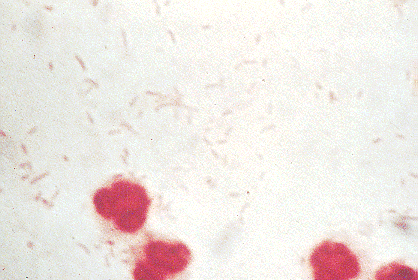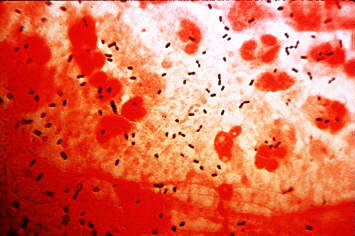STREPTOCOCCUS
STREPTOCOCCUS
The Streptococcus genus consists of Gram-positive bacteria which appear as chains
under microscopic observation. Members of Streptococcus can be aerobic, anaerobic, or microaerophilic. The organisms in
this genus are characterized by a coccus appearance, a thick cell wall, and aerobic action on glucose.
Four different classification systems exist:
(under the microscope)

CLINICAL
- Pyogenic Streptococci
- Oral Streptococci
- Enteric Streptococci
HEMOLYSYS
- alpha-hemolysis
- beta-hemolysis
- gamma-hemolysis
SEROLOGICAL-Lancefield (A-H), (K-U)
BIOCHEMICAL(physiological)
GROUP A
The first group in the Lancefield classification system includes only one species of Streptococcus,
S. pyogenes. This particular opportunistic pathogen is responsible for about
90% of all cases of pharyngitis. A common form of pharyngitis is "Strep throat" which is characterized
by inflamation and swelling of the throat, as well as development of pus-filled regions on the tonsils.
Penicillin is usually administered to patients as soon as possible to quell the possibility of the infection
spreading from the upper respiratory system into the lungs. Once in the lungs, the infection could give rise
to pneumonia. Some cases also develop into rheumatic fever if left untreated. Other diseases linked
to S. pyogenes are skin infections such as impetigo, cellulitis, and erysipelas.
LABORATORY INDICATIONS:
- Catalase -
- Beta-hemolysis
- Bacitracin sensitive
GROUP B
The B classification of Lancefield also includes only one bacterium, S. agalactiae. For years
this bacterium has been the causative agent in mastitis in cows. Currently, it has been found to be a
cause of sexually transmitted urogenital infections in females. Although infection is easily treated with
penicillin, proper diagnosis is necessary for women nearing labor because the infection can easily spread
to the child via the birth canal.
LABORATORY INDICATIONS:
- CAMP +
- Beta-hemolysis
GROUP D
Type D Streptococcus is the next clinically important bacterium because of the multitude of diseases
it is known to cause. Although many are harmless, the pathogenic strains cause complications of the
human digestive tract. This group has recently been reclassified into two divisions: Enterococcus and
non-Enterococcus. The Enterococci include E. faecalis, a cause of urinary tract infections,
and E. faecium, a bacterium resistant to many common antibiotics. Diseases such as septicemia, endocarditis, and
appendicitis have also been attributed to group D Strep. Steptococcus is part of he normal human fecal flora . Once identified, Group D Strep can be treated with
ampicillin alone or in combination with gentamicin.
LABORATORY INDICATIONS:
- Hydrolysis of bile esculin (dark brown medium)
-this indicates the ability of the bacteria to tolerate bile
- Growth in high salt conc.
OTHER IMPORTANT STREP
Streptococcus pneumoniae
(under the microscope)
 Because its surface carbohydrate antigens do not correspond to a specific Lancefield group, S. pneumoniae is
discussed separately. Although not given a letter designation, S. pneumoniae can be considered a Pyogenic
(puss-producing) strain of Strep. It can be distinguished from other Pyogenic bacteria by its high sensitivity
to Optochin (no growth zone of inhibition). This bacterium causes pneumonia, meningitis,
and otitis media. It also demonstrates alpha-hemolytic growth on blood agar.
Because its surface carbohydrate antigens do not correspond to a specific Lancefield group, S. pneumoniae is
discussed separately. Although not given a letter designation, S. pneumoniae can be considered a Pyogenic
(puss-producing) strain of Strep. It can be distinguished from other Pyogenic bacteria by its high sensitivity
to Optochin (no growth zone of inhibition). This bacterium causes pneumonia, meningitis,
and otitis media. It also demonstrates alpha-hemolytic growth on blood agar.
Viridans Group
The Viridans Streptococci, consisting of S. mutans and S. mitis, are alpha-hemolytic bacteria.
These bacteria inhabit the mouth. In fact, a large percentage of tooth decay can be attributed to
S. mutans.




Copyright © 1995 University of Texas - Houston Medical School, DPALM MEDIC, All rights reserved.

 Because its surface carbohydrate antigens do not correspond to a specific Lancefield group, S. pneumoniae is
discussed separately. Although not given a letter designation, S. pneumoniae can be considered a Pyogenic
(puss-producing) strain of Strep. It can be distinguished from other Pyogenic bacteria by its high sensitivity
to Optochin (no growth zone of inhibition). This bacterium causes pneumonia, meningitis,
and otitis media. It also demonstrates alpha-hemolytic growth on blood agar.
Because its surface carbohydrate antigens do not correspond to a specific Lancefield group, S. pneumoniae is
discussed separately. Although not given a letter designation, S. pneumoniae can be considered a Pyogenic
(puss-producing) strain of Strep. It can be distinguished from other Pyogenic bacteria by its high sensitivity
to Optochin (no growth zone of inhibition). This bacterium causes pneumonia, meningitis,
and otitis media. It also demonstrates alpha-hemolytic growth on blood agar.


